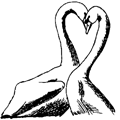Papers in the Biological Sciences

Handbook of Waterfowl Behavior by Paul A. Johnsgard
Date of this Version
January 1965
Document Type
Book Chapter
Abstract
The tribe includes 20 species of which two are extinct. Except for two Southern Hemisphere species, the group is of northern and arctic distribution. All species consume a high proportion of animal material, although they are by no means all "sea" ducks. All dive extremely well, although the manner of diving varies in that some species usually open their wings when diving and others never do. All the species except the isolated Southern Hemisphere forms exhibit considerable sexual dimorphism in plumage, voice, and behavior, and there is much sympatry of ranges. Some genera (Somateria, Polysticta, Clangula, Melanitta) normally nest on the ground, and those species which usually nest in the open (the eiders) tend to have cryptic and disruptively patterned female plumages. The other species tend to nest in crevices or holes in the ground (the harlequin), or in trees, and females of these species lack such cryptic coloration. Metallic coloration is restricted to male head plumage in most species, but there is a metallic-colored speculum in two genera (Polysticta and Histrionicus). The other species either have white wing-specula or lack any wing patterning.


Comments
From Handbook of Waterfowl Behavior by Paul A. Johnsgard. Copyright © 1965 Cornell University Press; electronic edition copyright © 2008 Paul A. Johnsgard.